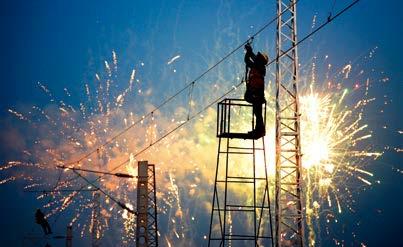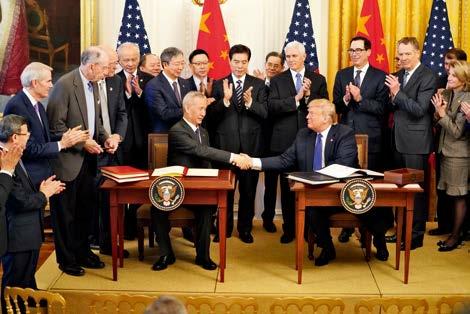A Special Spring Festival
2020-03-23

A Special Spring Festival
January 24, Wuhan, Hubei Province: A medical worker and a recovering pneumonia patient exchange Chinese New Year greetings on Lunar New Years Eve in the ICU (intensive care unit) of Zhongnan Hospital of Wuhan University.
While most Chinese families prepared for the 2020 Spring Festival, or Lunar New Year, an outbreak of a novel coronavirus (2019-nCoV) hit the country. Wuhan is the epicenter of the outbreak. Chinese President Xi Jinping, also general secretary of the Communist Party of China (CPC) Central Committee, urged all-out efforts to prevent and control the novel coronavirus pneumonia while chairing a meeting of the Standing Committee of the Political Bureau of the CPC Central Committee on January 25. As long as the nation has strong confidence and makes joint efforts with scientific and targeted measures, the battle to prevent and control the contagion will be won, Xi said.
Securing the Travel Rush
January 7, Xian, Shaanxi Province: Electricians set the electrical system for a railway line linking Xinfeng and Yaocun. The 23.1-kilometer rail line helps ease traffic pressure on the Xinfeng Railway Station in Xian, the capital city of northwestern Chinas Shaanxi Province.
As most of the people in China took time off to spend the Spring Festival holiday, many railway workers would remain on duty, including those conducting maintenance checks to secure safe trips for the Spring Festival travel rush which lasts for 40 days from January 10 to February 18 this year.
Hard-won Outcome
January 15, Washington, D.C., U.S.A.: U.S. President Donald Trump and Chinese Vice Premier Liu He, also a member of the Political Bureau of the CPC Central Committee and chief of the Chinese side of the China-U.S. comprehensive economic dialogue, shake hands after signing the China-U.S. phase-one economic and trade agreement during a ceremony at the East Room of the White House.
After nearly two years of strenuous negotiations, the two largest economies signed agreements to inject stability into bilateral relations and global growth.
It “shows that our two countries have the ability to act on the basis of equality and mutual respect, and work through dialogue and consultation to properly handle and effectively resolve relevant issues,” read a message from Chinese President Xi Jinping relayed to Trump at the signing ceremony.

“China Speed” Indeed
January 10, Beijing: Passengers take pictures of a paper-cut on the window of the G8811 high-speed train bound for the Taizicheng Railway Station on the new Beijing-Zhangjiakou High-speed Railway.
After Chinas first independently designed and constructed railway began connecting Beijing and Zhangjiakou in 1909, a new high-speed railway line between the two cities opened on December 30, 2019 to facilitate transportation between the co-hosts of the 2022 Winter Olympics.
A steep change from 35 to 350 kilometers per hour, the 110-year-old Beijing-Zhangjiakou rail line is a testament to “China speed.” The total length of Chinas railroad lines in service now exceeds 139,000 kilometers, including 35,000 kilometers of high-speed rail, the most in the world. High-speed rail is not just a means of transport but also a key driver of economic development.
New Look for Old Custom
January 14, Zhangye, Gansu Province: A birds-eye view of the dazzling Jiuqu Yellow River Lights Array during testing. It is an intangible cultural heritage of Gansu Province.
This year, the annual folk activity is scheduled to be held from January 29 to February 11 to celebrate Spring Festival and Lantern Festival (which falls on February 8, the 15th day of the first lunar month this year). The activity has embraced innovation including modern lighting and audio equipment such as lasers and computer lighting this year.
The lighting arrays originated from rituals of the Shang Dynasty(1600-1046 B.C.), surviving as a historical and cultural heritage with thousands of years of history. In 2019, it was recognized as Chinas largest-scale lights array by Shanghai China Records Headquarters.
